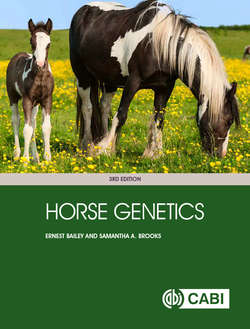Читать книгу Horse Genetics - Ernest Bailey - Страница 73
На сайте Литреса книга снята с продажи.
Altered ratios for lethal alleles
ОглавлениеThe dominant White coat color gene (W) is one of the earliest lethal genes described for horses. Molecular genetic studies have determined several mutations that are responsible for dominant white in horses, and these are discussed in Chapter 9. A breeding study by Pulos and Hutt (1969) suggested that at least one of the mutations that causes a white coat could cause embryonic losses. In matings between white horses, both solid color (non-white) and white foals were always produced, demonstrating that the gene for white coat color (W) was dominant to the non-white gene (w). However, the ratio of white to colored foals (28:15) from matings of heterozygous white horses (W/w) did not correspond to the expected ratio of 3:1 that would be expected in matings of known heterozygotes (Table 5.3). In this case, the results more closely approximated a 2:1 ratio. This could be explained if homozygous white (W/W) offspring are lost as embryos, and only the heterozygous white and the non-white offspring make it to term, as shown in Table 5.3. Consistent with this observation, the authors of the study did not observe true-breeding white horses (homozygotes) in their herd (Pulos and Hutt, 1969).
Table 5.3. If all classes of offspring are equally viable, the proportion of white to colored offspring from matings between white horses heterozygous for the dominant White gene W is expected to be 3:1., i.e. 3 white, 1 colored. If one homozygous class is lethal (example, 25%), then the proportion of white to colored would be 2:1. Relatively large numbers of offspring might be needed to distinguish between a 3:1 and a 2:1 ratio.
